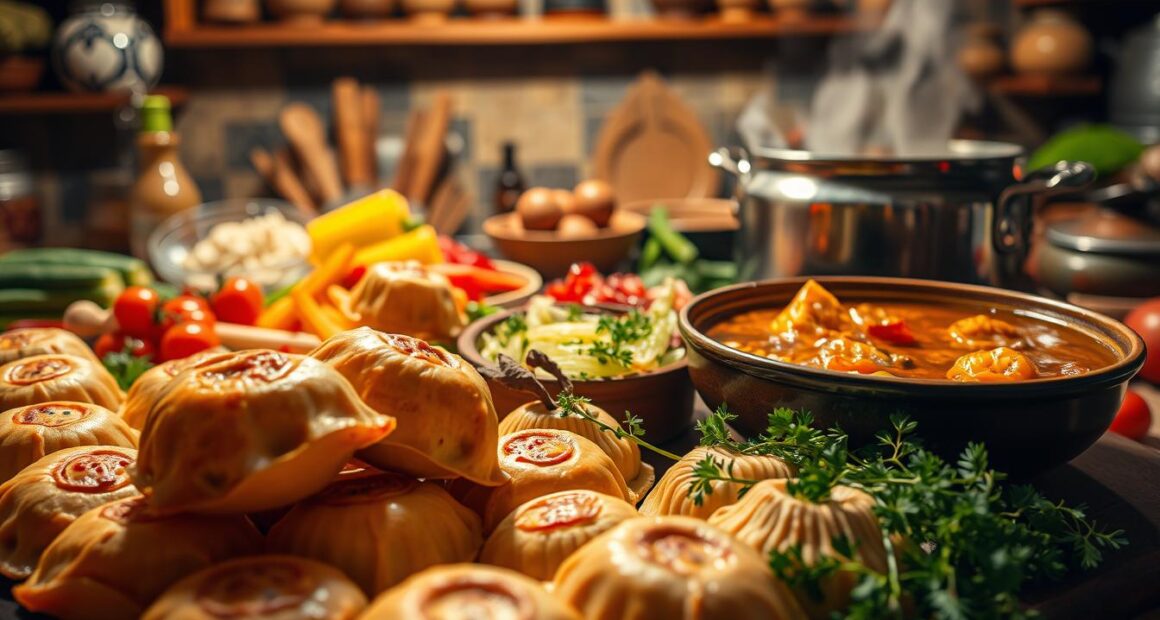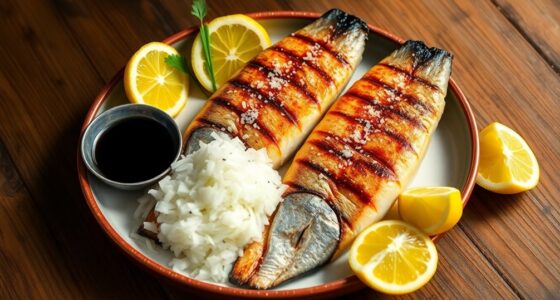Imagine walking into a cozy kitchen filled with the aromatic essence of warm spices and freshly baked bread, the kind of place where laughter mingles effortlessly with enticing scents. This is the heart of Tatar cuisine, where each dish tells a story, intertwined with the rich tapestry of Tatar food culture and its vibrant history. You can practically feel the love poured into traditional Tatar dishes, from the flaky meat pies famously known as belyashi to the mouthwatering sweetness of chak-chak. Every bite serves not just to satisfy your hunger, but also to bridge connections, flavors, and generations.
As you explore the world of Tatar recipes, you’ll discover more than just ingredients; you’ll find a culinary adventure that offers a glimpse into the cultural soul of Tatarstan. Join us in delving into these savory delights, and let each dish transport you to a place infused with tradition, flavor, and heartfelt memories.
Key Takeaways
- Tatar cuisine showcases a unique blend of flavors, deeply rooted in its cultural heritage.
- Traditional Tatar dishes like belyashi and chak-chak offer more than sustenance—their recipes evoke memories and traditions.
- Exploring Tatar recipes can inspire your culinary journey while introducing you to new flavors and cooking techniques.
- Tatar food culture emphasizes community and connection, often being central to family gatherings and celebrations.
- Learning about Tatar cuisine opens doors to a rich history and cultural significance behind each meal.
What is Tatar Cuisine?
Tatar cuisine reflects a rich history marked by cultural exchanges and agricultural practices. Over the centuries, it has incorporated diverse influences, creating a unique blend of flavors and textures. You can trace tatar cuisine history back to the nomadic lifestyles of the Volga Bulgars, which laid the foundation for what is now recognized as Tatar culinary traditions. The importance of livestock farming shaped traditional Tatar dishes, introducing ingredients like beef, mutton, and horse meat into the everyday diet. As a result, the culinary landscape of Tatarstan is not only varied but also rooted in deep cultural significance.
A Brief History of Tatar Cuisine
The evolution of Tatar cuisine reveals a fascinating tapestry of influences and adaptations. As communities developed, their culinary practices diversified, shaped by interactions with neighboring cultures such as Russians and Central Asians. Historical events, including migrations and trade, played a crucial role in introducing new ingredients and cooking methods. This rich tatar cuisine history highlights the resilience and adaptability of Tatar people through centuries, creating a vibrant culinary heritage that continues to thrive today.
Key Ingredients in Tatar Dishes
Understanding the key ingredients in Tatar dishes enhances your appreciation for this unique cuisine. Staples such as grains, dairy, and various meats serve as the foundation for many traditional tatar dishes. The wide array of available ingredients reflects the agricultural practices in Tatarstan, where crops and livestock flourish. Some key ingredients include:
- Meats: Beef, mutton, and horse meat are prevalent, often featured in hearty stews and pastries.
- Grains: Flour, rice, and millet provide the basis for many baked goods and side dishes.
- Dairy: Sour cream and yogurt add creaminess and tang to various recipes.
Regional Variations of Tatar Cuisine
Tatar cuisine showcases a delightful range of flavors that vary by region. These distinct variations arise from differences in local ingredients and customs. For example, you may find unique takes on echpochmak or chak-chak across Tatarstan. A synchrony of tastes allows you to explore an array of traditional Tatar dishes while embracing the cultural diversity within the community. The table below outlines some notable regional variations:
| Region | Signature Dish | Key Ingredients |
|---|---|---|
| Kazan | Eqor Borsh | Beef, potatoes, spices |
| Buinsk | Kystybyi | Flatbread, various fillings |
| Naberezhnye Chelny | Gubaidia | Meat, rice, raisins, cheese |
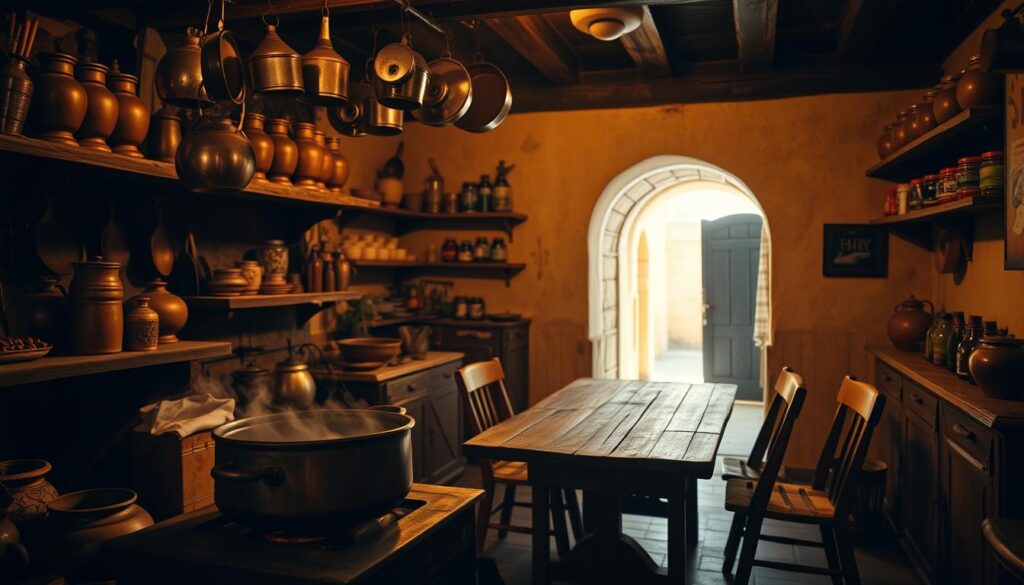
Essential Tatar Dishes You Must Try
If you’re looking to explore essential Tatar dishes, you are in for a delightful culinary adventure. Authentic Tatar cuisine is rich in flavors and traditions, showcasing a harmonious blend of ingredients that reflect the culture’s nomadic roots and agricultural practices. Here are three must-try dishes that capture the essence of Tatar cooking and make for fantastic additions to your recipe repertoire.
Eshkene – A Tasty Dumpling Delicacy
Eshkene is a delicious dumpling that embodies the warm hospitality of Tatar culture. This dish features a soft dough filled with spiced meat, often lamb or beef. When you take a bite, the juicy filling bursts with flavor, making it an inviting choice for family gatherings or cozy dinners. As you savor Eshkene, you’ll appreciate its role among essential Tatar dishes.
Chak-Chak – Sweetness You Can’t Resist
For those with a sweet tooth, Chak-Chak is a standout treat in authentic Tatar cuisine. This honey-drenched pastry is a celebration in itself and is traditionally served during festivities such as weddings and family reunions. The delightful crunch of the pastry pieces, combined with the sweet syrup, creates a mouthwatering dessert that you simply cannot resist. It truly exemplifies the outstanding variety of Tatar recipes filled with rich flavor.
Pilaf – A Classic Tatar Comfort Food
Pilaf is another essential dish that reflects the heart of Tatar cuisine. This comforting meal is typically made with rice, tender pieces of meat, and a medley of spices, offering a warm and satisfying experience. Often enjoyed during family meals, Pilaf showcases the culinary skills of Tatar cooks and serves as a perfect introduction to the depth of flavors found in Tatar recipes.

Traditional Tatar Beverages
Drinks hold a special place in Tatar food culture, reflecting the history and traditions of the region. Traditional Tatar drinks such as ayran and kvass offer refreshing options that pair perfectly with meals. These beverages showcase the agricultural roots and culinary practices that have evolved over centuries.
Ayran – Refreshing Yogurt Drink
Ayran stands out as a cooling beverage made from yogurt, water, and a pinch of salt. This drink serves as a popular choice during the sweltering summer months, providing hydration and nutrition. Ayran complements many Tatar dishes, enhancing flavors and promoting a sense of satisfaction.
Kvass – A Traditional Fermented Beverage
Kvass is another noteworthy Tatar beverage, boasting a mildly alcoholic content derived from fermented rye bread. Its complex flavors make it a delightful pairing with various meals. Often enjoyed on its own or shared during social gatherings, kvass reflects the communal spirit embedded in Tatar culture. Both ayran and kvass represent essential tatar beverages that maintain a vital role in everyday life and festive occasions alike.

The Art of Tatar Baking
Tatar baking showcases a rich heritage steeped in tradition and creativity. Known for its delightful variety, Tatar baking features an array of breads and pastries that are emblematic of Tatar food culture. From savory to sweet, each item reflects the cultural significance and local ingredients that are integral to this culinary art.
Popular Tatar Breads
Among the array of traditional Tatar breads, you will find beloved varieties such as:
- Kystybyi: A versatile flatbread often filled with potatoes or other savory ingredients.
- Belish: A rich pie typically filled with minced meat and potatoes, showcasing the hearty nature of Tatar pastries.
- Cheburek: A deep-fried pastry filled with meat, celebrated for its popularity in Tatar regions and beyond.
The art of Tatar baking emphasizes the use of high-quality ingredients, ensuring both flavor and texture resonate in these classic creations.
Sweet Pastries and Their Significance
Sweet treats play a significant role in Tatar festivities, with traditional Tatar pastries capturing the heart of Tatar food culture. Two standout desserts include:
- Chak-Chak: A beloved dessert made from fried wheat dough, drizzled with honey, offering a taste that is adored worldwide.
- Gubaidia: This festive pie layers meat, rice, raisins, and cheese, symbolizing celebration and communal joy.
The preparation of these pastries often involves meticulous care, embodying the artistry of Tatar baking. From celebratory occasions to daily meals, these sweet delights echo the cultural depth and significance of Tatar culinary traditions.

Tatar Cuisine at Home: Cooking Tips
Embracing authentic Tatar cuisine at home can be an exciting culinary adventure. For beginners, starting with simple yet delicious tatar recipes makes the journey enjoyable and rewarding. Concentrating on fundamental ingredients, along with essential cooking tips for Tatar cuisine, elevates your cooking skills while allowing you to savor the rich flavors of Tatar traditions.
Easy Recipes for Beginners
Popular dishes like pilaf and kystybyi are excellent choices as you begin your Tatar culinary journey. Each recipe serves around 15-20 people, showcasing the communal aspect of Tatar meals. For instance, a pot of pilaf typically requires:
| Ingredient | Quantity |
|---|---|
| Eggs | 5 |
| Flour | 600 g |
| Chicken Meat | 1 kg |
| Onions | 1 kg |
| Chicken Fat | 500 g |
The cooking time for ravioli is about 40-45 minutes on low heat, allowing the flavors to meld beautifully. Don’t forget to let the dough rest for 15-20 minutes before rolling, achieving a perfect thickness of around 7 cm at the center. For every egg used in the dough, 120 g of flour is necessary, making it easy to scale as needed.
Must-Have Cooking Tools for Tatar Cuisine
Having the right tools is crucial for successfully preparing authentic Tatar cuisine. Consider investing in:
- Heavy-bottomed pots for even cooking of pilaf.
- Rolling pins for creating perfect dough for pastries and dumplings.
- Sharp knives for hand-chopping meats, especially tender cuts like beef tenderloin for dishes like tartare.
- Sanitizing solutions to ensure food safety, such as using a diluted bleach solution for cleaning surfaces.
By incorporating these ingredients and tools, you can prepare mouthwatering tatar recipes in your own kitchen. Enjoy the flavors and techniques that make Tatar cuisine so special.
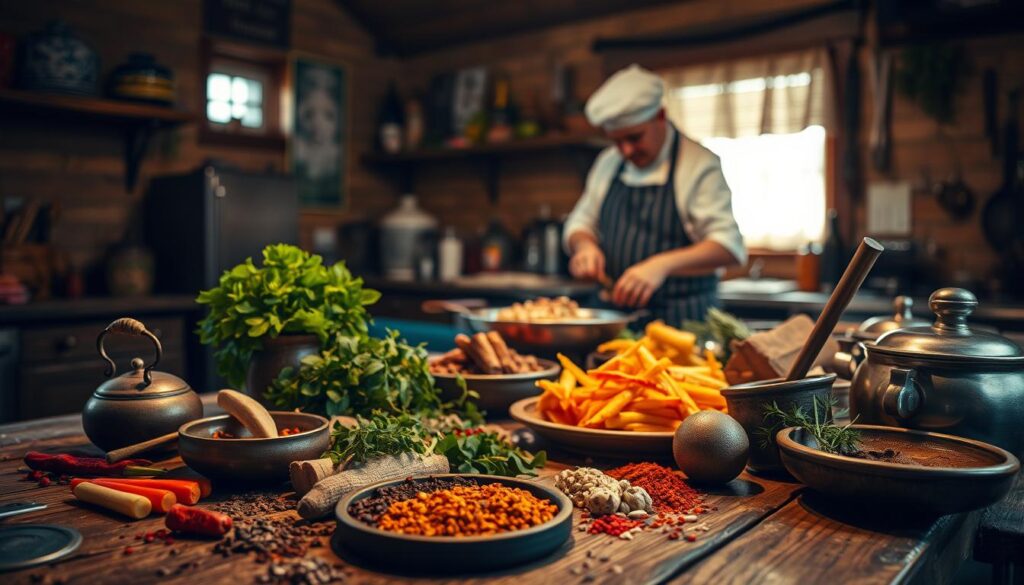
Dining Experiences: Where to Enjoy Tatar Cuisine
If you’re eager to dive into the world of Tatar culinary traditions, finding the right location to savor this delightful cuisine is essential. Several establishments across the U.S. highlight the rich flavors and vibrant culture associated with Tatar food. You can explore an inviting café, participate in food festivals, or discover pop-up events celebrating these unique dishes.
Local Tatar Restaurants in the U.S.
One standout among the best tatar restaurants is AyDea Café, located in San Francisco. This café is notable for being the only establishment in the U.S. that serves food from the Republic of Tatarstan outside of Russia. The café prides itself on utilizing fresh, locally sourced ingredients, including raw dairy and grass-fed beef. The menu showcases nine types of dough crafted from scratch for various dishes such as:
| Dish | Description |
|---|---|
| Qistibi | Flatbread filled with creamy mashed potatoes. |
| Uchpuchmak | Triangular meat pie, a flavorful treat. |
| Peremech | Fried dough with beef or mushroom patties. |
| Okroshka | A refreshing cold soup, likened to “gazpacho of the post-Soviet Union.” |
With a focus on bringing their daughters closer to their Tatar heritage, owners Chris Dumesnil and Liliya Battalova are committed to promoting these culinary traditions. Dinner service will soon expand the café’s offerings, making it an excellent choice for anyone seeking authentic Tatar experiences.
Tatar Food Festivals Worth Visiting
Tatar food festivals provide an exciting opportunity to embrace diverse Tatar culinary traditions. These gatherings not only feature a wide range of dishes but also foster a sense of community among attendees. At these festivals, you can sample everything from chebureks, filled with minced meat and fried to perfection, to desserts like chak-chak, a sweet wheat pastry. Such celebrations highlight the communal aspect of Tatar culture, making them a must-visit for enthusiasts and newcomers alike.

Exploring Tatar Spices and Flavors
Tatar cuisine showcases an array of bold and delightful spices that elevate every dish. The distinct tatar spices include a variety of herbs sourced from the lush local forests, combined skillfully with cumin, coriander, and other flavorful ingredients. This exceptional blend adds depth and complexity to traditional Tatar dishes.
Signature Spices in Tatar Cooking
Key spices often featured in authentic Tatar recipes contribute to the unique taste profile of this culinary tradition. Here are some of the most significant:
| Spice | Flavor Profile | Common Uses |
|---|---|---|
| Cumin | Earthy and warm | Often used in meat dishes like Azu and Kullama |
| Coriander | Citrusy and sweet | Enhances stews and soups |
| Bay Leaves | Aromatic and slightly bitter | Adds depth to broths and meat dishes |
| Black Pepper | Spicy and pungent | Common seasoning across various dishes |
How to Incorporate Tatar Flavors into Your Meals
You can easily introduce Tatar flavors into your cooking at home. Start by incorporating Tatar flavors into familiar dishes. Here are some suggestions:
- Add cumin to your next stew for a warm, aromatic experience.
- Use coriander in a salad dressing to infuse a refreshing twist.
- Spice up your roasted vegetables with a blend of black pepper and bay leaves.
These techniques will help you explore the rich tapestry of traditional Tatar cuisine while creating a delightful culinary experience that resonates with Tatar heritage.

Tatar Cuisine and Cultural Significance
Tatar food culture is rich with traditions that connect people through shared meals and celebrations. Family gatherings often center around the preparation and enjoyment of traditional Tatar dishes, fostering a sense of unity. The cultural significance of Tatar cuisine extends beyond the plate, reflecting a deep heritage that emphasizes community and celebration.
Family Gatherings and Food Traditions
During family events, dishes like echpochmak, a baked pastry filled with lamb, potatoes, and onions, take center stage. This dish, named for its triangular shape, is a staple in Tatar households. Traditional recipes often emphasize communal eating, reinforcing the importance of sharing meals as a cherished family tradition. As families gather, the aroma of homemade traditional Tatar dishes fills the air, creating memories that last a lifetime.
Festivals Celebrated with Tatar Dishes
Cultural festivities, such as Sabantuy, showcase the vibrant Tatar food culture. This festival features not only the enjoyment of food but also traditional dances and music, uniting communities in celebration. Special dishes prepared during Sabantuy highlight the rich flavors of Tatar cuisine, attracting visitors and locals alike. The cultural significance of Tatar cuisine shines through these gatherings, emphasizing the role that food plays in community identity and continuity.

Vegetarian and Vegan Tatar Options
If you are exploring delicious vegetarian tatar recipes or want to dive into the world of vegan tatar cuisine, you’ll find that Tatar food can easily accommodate various dietary preferences. The essence of Tatar cuisine not only relies on its rich flavors but also adapts to include plant-based ingredients that maintain the original character of the dishes.
Plant-Based Tatar Recipes
A standout example is the vegan beetroot tartare, a vibrant dish perfect for any occasion. This no-cook recipe takes about 15 minutes to prepare. Instead of traditional beef, you can use 450 grams (1 pound) of pre-cooked beets, finely minced shallots or red onions, and capers for a delightful zing. For added flavor, a marinade of mustard and balsamic vinegar mixed with optional maple syrup pairs beautifully with the earthy sweetness of beets.
The recipe can be further enhanced with a variety of ingredients including tomatoes, cucumbers, jalapeno peppers, and roasted red peppers. Here’s a structured look at the beet root tartare:
| Ingredient | Quantity |
|---|---|
| Beetroots (pre-cooked) | 450 grams (1 pound) |
| Shallot (or red onion) | 1 medium |
| Capers | 2 tablespoons |
| Parsley | 30 grams (½ cup) |
| Dressing (mustard and balsamic vinegar) | 2 teaspoons and 1.5 teaspoons |
| Maple syrup (optional) | 1 tablespoon |
| Black pepper | To taste |
| Walnuts or sunflower seeds | For garnish |
Substitutions for Traditional Ingredients
Adapting traditional ingredients for vegan tatar cuisine is straightforward. Dairy can be easily substituted with plant-based alternatives like almond milk or vegan yogurt, ensuring that you preserve the dishes’ original texture and flavor. When preparing the beet tartare, consider using quality accompaniments such as sourdough or multigrain bread while also serving it with olives, hummus, or vegan cheese for added variety. This makes it not only delicious but also appealing for a communal dining experience.
Through these tatar food cultural adaptations, you can enjoy Tatar cuisine without compromising your dietary choices. Your guests will love the flavors and creativity that come with vegetarian and vegan options.
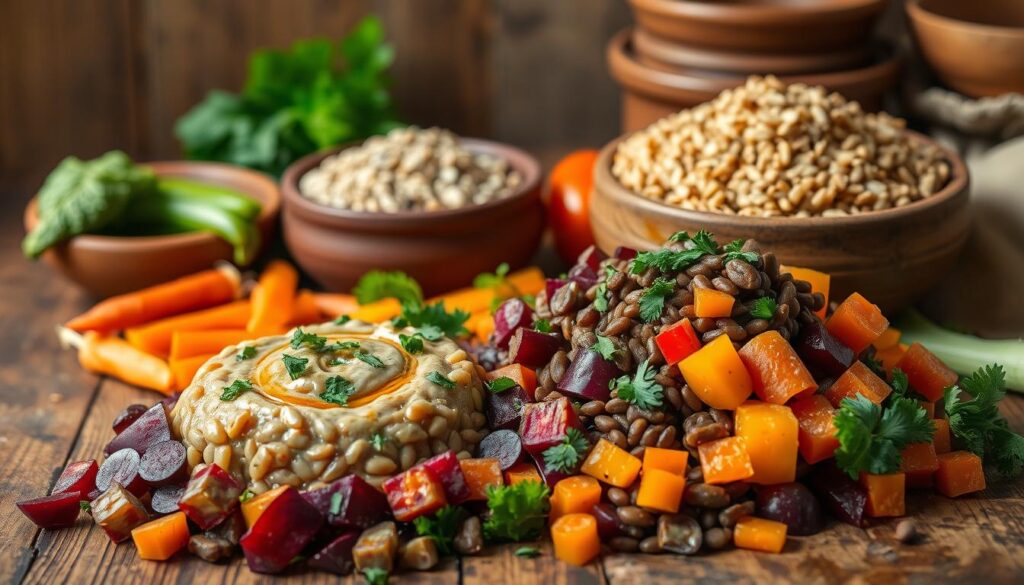
Discovering Tatar Street Food
Tatar street food perfectly encapsulates the rich flavors and culinary traditions of Tatar food culture. As you stroll through bustling markets or enjoy local festivals, be sure to indulge in the delightful variety of tatar snacks available. These quick bites reflect the heart and soul of Tatar cuisine, making them a must-try for anyone craving a taste of authenticity.
Tatar Snacks You Need to Try
Among the popular tatar snacks, cheburek stands out with its crispy exterior enveloping juicy meat filling, providing a satisfying crunch with each bite. Peremech, another delightful option, features fried dough stuffed with flavorful fillings. Both these dishes offer a glimpse into the tantalizing world of tatar street food, showcasing the delicious and hearty flavors that characterize Tatar cuisine.
The Rise of Tatar Food Trucks
The contemporary interest in Tatar food is mirrored in the growing popularity of food trucks dedicated to serving tatar snacks. These mobile eateries make it easier than ever to enjoy authentic Tatar flavors at various events and gatherings. With offerings such as Kystybai and echpochmak, these food trucks represent a new wave of Tatar food culture, making traditional flavors accessible to a wider audience.
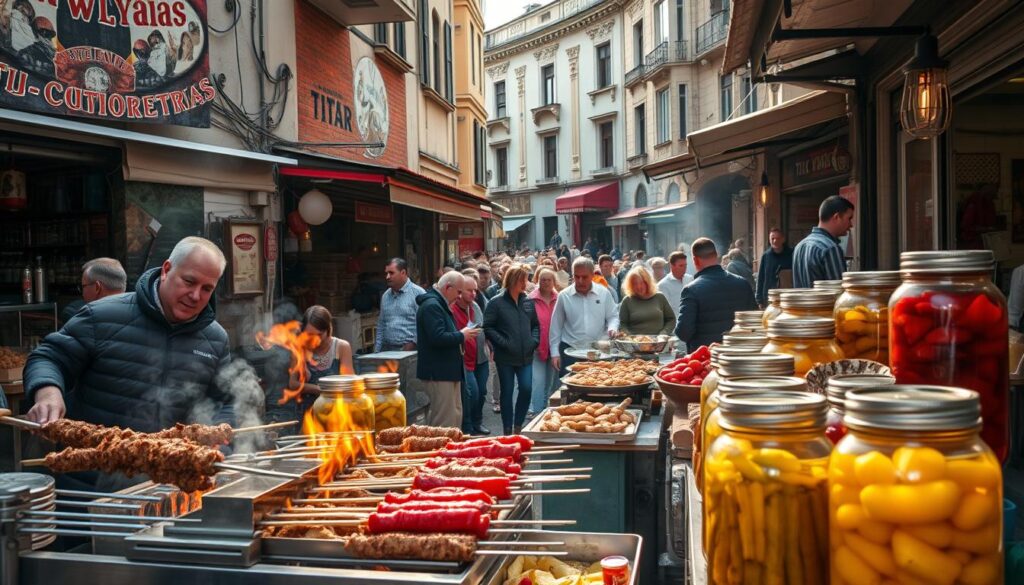
How to Host a Tatar-Themed Dinner Party
Hosting tatar dinner parties allows you to immerse your guests in the rich flavors and traditions of authentic tatar cuisine. Begin by planning a tatar-inspired menu that showcases essential dishes such as pilaf, ochpochmak, and chak-chak. These selections not only highlight the unique taste of Tatar cooking but also create a warm, inviting atmosphere for your gathering.
Authentic Menu Ideas
Consider creating a multi-course meal that reflects the depth of Tatar cuisine. Here are some tatar-inspired menu ideas for a memorable dining experience:
- Appetizers: Serve pirozhki filled with meat or vegetables and a refreshing salad with marinated vegetables.
- Main Courses: Highlight dishes such as pilaf, with tender rice blended with meat and spices, and ochpochmak, a delectable pastry filled with meat and potatoes.
- Desserts: End on a sweet note with chak-chak, a honey-soaked pastry that is always a crowd-pleaser.
Tatar-inspired Decorations and Atmosphere
Enhance your dinner party with Tatar-inspired decorations. Consider table settings that reflect Tatar traditions, including colorful tablecloths and beautifully crafted dishes. Use traditional utensils, such as wooden serving platters and decorative bowls, to truly celebrate the culinary arts. Setting the mood with Tatar music in the background can further create an inviting ambiance that pays homage to the culture.

By thoughtfully incorporating these elements into your soirée, you can offer your guests a genuine taste of Tatar culture. Hosting tatar dinner parties not only showcases the delights of a tatar-inspired menu but also invites friends to share in the stories and traditions that make authentic tatar cuisine truly special.
| Course | Dishes |
|---|---|
| Appetizers | Pirozhki, Marinated Vegetable Salad |
| Main Course | Pilaf, Ochpochmak |
| Dessert | Chak-Chak |
Tatar Cuisine: A Culinary Adventure
The journey of Tatar cuisine is not confined to its origins; it’s an expansive culinary adventure that is making waves beyond its geographical borders. As more food enthusiasts across the globe experience the rich flavors of Tatar dishes, there’s a growing recognition of the vibrant cultural heritage this cuisine represents. You can delight in traditional pastries like echpochmak and chak-chak, which encapsulate Tatar traditions, and embrace the diversity of flavors intrinsic to Tatar food. This cultural expansion invites everyone to explore an array of dishes that range from comforting noodle soups to exquisite rice pilafs.
Exploring Tatar Cuisine Beyond Borders
The popularity of Tatar cuisine is steadily increasing in America, indicating a promising future for Tatar food cultural expansion. Diners are discovering hearty favorites such as kystybyi, often filled with millet or savory meats, and the delicate sweetness of gubadiya. Restaurants and cafes are beginning to highlight these dishes, blending them with local tastes and encouraging a deeper appreciation for this unique culinary tradition. As a reader and food enthusiast, embracing these flavors forms part of a broader journey into the world of Tatar cuisine.
The Future of Tatar Cuisine in America
Looking ahead, the future of Tatar cuisine seems bright with the introduction of cooking classes, culinary festivals, and specialized Tatar dining experiences. This not only facilitates cultural exchange but also ensures that the essence of Tatar cooking, which is often marked by its emphasis on family recipes passed down through generations, continues to thrive. Engaging with this cuisine allows you to savor not just the food, but also the storied history that accompanies each dish, affirming the role of Tatar cuisine in a culturally diverse and evolving culinary landscape.
